![]()
![]()
![]()
Use LEFT and RIGHT arrow keys to navigate between flashcards;
Use UP and DOWN arrow keys to flip the card;
H to show hint;
A reads text to speech;
21 Cards in this Set
- Front
- Back
- 3rd side (hint)
|
• Outline under what circumstances you might ?consider using foetotomy in bovine obstetrics.
|
• Dead foetus
• Emphysematous foetus • Relatively oversized foetus • Abnormal presentation, position or posture that cannot be corrected • Congenital abnormalities that prevent normal birth • Incomplete cervical dilation • Hip lock and foetus is dead • Can avoid a caesarian in lactating/valuable cow where surgery may delay recovery or increase chance of infertility • Case selection: Cow should be able to stand, bright and alert and uterus intact |
|
|
|
• What are the advantages and disadvantages of
using foetotomy? |
Advatages: Can avoid caesarian in lactating/valuable cow, avoid surgery that may delay cows recovery or increase risk of infertility.
Disadvantages: Requires Foetus to be dead/loss of the calf. Potential contamination of yourself & uterus (if you later choose c-section), risk trauma to uterus. Mentally & physically tiring for vet. Cows need to be standing, bright & alert with intact uterus for Foetotomy. Some owners may find foetotomy distressing (Particularly horses). |
|
|
|
• Outline the technique for percutaneous foetotomy
with a foetus in: a) cranial, longitudinal presentation, dorso-pubic position with extension of both front legs b) caudal, longitudinal presentation, dorso-pubic position with extension of both hind legs |
Percutaneous foetotomy – Head of foetotome is located dorsal and caudal to the scapula. The wire is placed between the claws as the head of the foetatome is advanced along the lateral aspect of the limb to the level of the crest of the scapula. When the head of the foetome is in place the wire is released medially to lie within the axillary region.
caudal presentation Removal of hind leg - foetatome should be placed cranial to the greater trochanter of the leg to be removed. As with the forelimb, the wire is placed between the claws before the head of the foetatome is advanced •Transverse sections can then be performed in the lumbar and thoracic regions |
|
|
|
• Describe how you would remove a forelimb using
subcutaneous foetotomy from an emphysematous calf in cranial, longitudinal presentation, dorsopubic position with extension of both front legs |
Use palm knife place a longitudinal skin incision on the dorsal aspect of the limb from as far up the lim as possible to the second phalanx.
Bluntly separate skin from underlying tissue with fingers or spatular. Sever muscular attachments between thorax & medial scapular. Disarticulate fetlock joint leaving digits attached to disconnected skin. Attach rope or chain above knee with a second loop around metacarpalphalangeal (cannon bone) & remove forelimb. |
|
|
|
• Describe your approach to delivery of a foetus in
caudal, longitudinal presentation, dorsopubic position with bilateral flexion of the hips where the malpresentation cannot be corrected and the foetus is emphysematous |
If returning the limb to hock flexion fails, a foetotomy cut may be used to remove a hindlimb
• Head of foetotome should lie diagonally opposite tail head to help ensure that the femoral head is removed during the cut • Alternatively, subcutaneous foetotomy may be used to remove the hindlimb. If foetus is jammed in maternal pelvis Insert the head of a pre-threaded foetotome over the foetus dorsally until it reaches the level of the caudal most ribs of the foetus Position the wire caudally at the base of the foetalhind end, 2 to 3 cm below the ischiatic tuberosities. This wills severe the foetal hind limbs near the proximal part of the femur and incise through the foetal abodmen and the caudal thoracic or lumbar region of the foetus. The hind limbs, then the foetal pelvis can be extracted. |
|
|
|
The head of a dead foal is protruding from the vulva of a
mare • List 1 presentation, position and postures that could result in this presentation • Outline yourn approach to the treatment of this case |
Presentation - Cranial Longitudinal
Position - Dorsosacral Presentation - Bilateral shoulder flexion Place snare on head of foetus then repel it. Attempt to revert to carpal flexion in both limbs & deliver. As foetus is dead removal of head & neck may produce more space to correct the malpresentation. |
|
|
|
• You attend a heifer with a history of having been in
labour for at least 3 hours. The “first water bag has burst” and the second (the amnion) is still intact. You conduct a vaginal exam, rupture the amnion and determine that the calf is alive and presented normally. How will you determine if the calf is likely to be able to be delivered alive by traction? |
Assess size of calf & apply Diagnostic traction
|
|
|
|
Outline the clinical signs and treatment for a calf presented at term in a true breech position. What is the obstetrical terminology that is used to describe this presentation, position and posture?
|
Presentation = Caudal Longitudinal
Position = Dorsosacral Posture = Bilateral Hip flexion Clinical signs: Foetus does not engage with cervix, thus stimulus for abdominal contractions & 2nd stage labour is weak or absent • Owners may report animal has not shown signs of giving birth, prolonged first stage labour, restlessness, elevated tail and or blood at vulva only • Vaginal exam, detect tail, no limbs |
|
|
|
• Outline how you would correct a malpresented bovine foetus with:
– Carpal flexion – Incomplete dilation of the cervix with the cervix palpably soft, thin and dilated about 13 cm |
Carpal flexion - Treatment • Repel foetus & shoulder of
displaced limb •Grasp metacarpus of affected limb proximal to the fetlock •Flexed carpus is elevated dorsally, laterally & repelled cranially •When fetlock is above pubis the foot is extended, while cupping hand under foot to protect uterus/vaginal wall •Alternatively, a rope can be placed above the carpus, passed between the toes and the foot extended while applying traction to the rope & elevating the carpal joint dorsally and cranially. •Bilateral carpal flexion – Correct one limb at a time. |
Incomplete dilation of cervix - treatment
• If it occurs in association with premature examination during first stage of labour then leaving the animal for 2+ hours and then rechecking can result in resolution or partial resolution • Administration of a uterine relaxant may help lower myometrial tone and facilitate cervical dilation (β sympathomimetics eg isoxsuprine, clenbuterol) • If chorioallantois has ruptured and calf is valuable a caesarian section may be indicated • If hypocalcaemia is present, administer Ca and recheck in 2 hours (in practice if you attend such cases you usually deliver the calf rather than risk a revisit) • Correct uterine torsion if present • Partial dilatation – where adequate softening of cervix exists, correct any malposition and apply slow, steady traction with intermittent pauses to knead cervix over the calf and to allow cervix time to stretch. Apply copious lubricant. Risk of cervical tear. • Where cervix fails to dilate adequately or remains firm & thick a caesarian section is indicated |
|
|
• How might you correct a case of a twin pregnancy with one foetus presented cranially and the other
presented caudally |
Repel one foetus and deliver other foetus by traction.Usually deliver the most caudally presented foetus first or any foetus in caudal presentation as only the hindlimbs need to be manipulated. Explore uterus post delivery for other foetuses & treat with Oxytocin post delivery to facilitate uterine involution
|
|
|
|
• Outline the clinical signs and treatment for a bovine
schistosomus reflexus foetus: – in transverse ventral presentation – in transverse dorsal presentation |
Clinical signs: Dystocia with palpation of foetal viscera within the vaginal canal or visible externally. Viscera, must be differentiated from maternal viscera in the case of uterine rupture. Intestinal loops of foetus will be smaller than expected for the dam.
Palpation of multiple limbs within the vaginal canal with ankylosis of limbs and vertebral canal. Presentation options: Tx: Foetotomy usually attempted first as a long incision may be needed to deliver by caesarian section • Bisection following passage of a wire introducer around the foetal trunk can enable sufficient reduction in foetal size to enable delivery by traction • Easier for transverse ventral (viscera presented) than transverse dorsal (limbs presented) presentation • Caesarian section may be easier in the latter • In case of visceral presentation, remove viscera first, if still alive, break umbilical cord first |
|
|
|
You are called to examine a dairy cow with a history of
dystocia. On vaginal examination you detect what feel to be loops of intestine. What conditions could cause loops of intestine to be palpable within a uterus? |
uterine tear or rupture
Schistosoma reflexus Intestinal loops of foetus present |
|
|
|
How might you manage a dystocia with a calf with
hydrocephalus? |
Hydrocephalic foetus: A loop of wire from a prethreaded foetome can be placed around the scull, ventral to the ears to enable the dorsal part of the scull to be removed.
•Sometimes the hydrocephalic part of the skull can be manually crushed which avoids the need for a foetotomy cut. |
|
|
|
• What are the following drugs used for in obstetrical manipulations and what is their mode of action?
– Clenbuterol and isoxsuprine |
uterine relaxants may help lower myometrial tone and facilitate cervical dilation (β sympathomimetics eg isoxsuprine, clenbuterol)
|
|
|
|
Examination of a ewe with dystocia reveals a live foetus in cranial
presentation, with one forelimb retained within the birth canal. This foetus is most appropriately delivered by which one (1) of the following methods? a. Caesarian section b. Pubic symphisiotomy of the dam c. Foetotomy d. Judicious traction of the head and exposed forelimb e. Repulsion, followed by repositioning of the retained forelimb |
Answer: d, Lambs or kids in cranial presentation, with one forelimb retained can usually be delivered with judicious traction alone.
This should not be attempted with calves and foals as repulsion and repositioning of the forelimb is usually needed to gain sufficient room within the maternal pelvis to enable delivery of the foetus. |
|
|
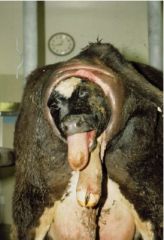
• Describe how you would manage this dystocia in a Holstein heifer
|
Bilateral shoulder flexion or incomplete extension of forelimbs may present as a foetal head protruding outside of the vulva only or if unilateral – head and 1 limb may present at vulva or external to vulva . The foetal head and tounge may be swollen.
First check viability of foetus – eye reflexes, apical HB. Place a snare on head prior to repelling it to allow it to be retrieved later then Repel foetus. Convert to carpal flexion and correct as per carpal flexion. •If foetus is dead, removal of head and possibly the neck with a foetotomy cut may produce more space to correct the malpresentation. If delivered alive these calves may need to be supplementary fed with milk via a stomach tube until the swelling in the tongue dissipates sufficiently to enable them to suckle |
|
|
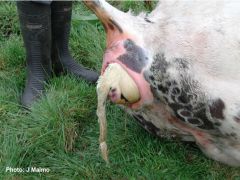
Outline your approach to the correction of this dystocia
|
Suspect Hock flexion
Repel foetal hind leg with pressure to perineum. Grasp metatarsus & repel limb cranially & direct hock laterally. Then moving hoof caudally & medially into pelvic canal. If possible have hand cupped over hoof to minimise risk of uterine damage/rupture. Once both limbs extended use diagnostic traction to determine if it can be delivered vaginally. |
|
|

Outline your approach to the correction of this dystocia
|
Suspected shoulder flexion due to - head & one limb present, swollen head & tongue swollen
First check viability of calf - check for eye reflex, if you can access feel for apex of heart, deep pain reflex. Place snare on head before repelling foetus, attempt to convert to carpal flexion the correct carpal flexion as normal. Then apply diagnostic traction. If foetus is dead removal of head & neck with a foetotomy cut may allow more space to correct. |
|
|
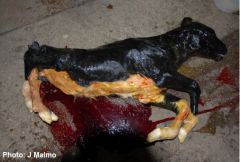
An abnormal calf is delivered following a dystocia.
Name the condition. What is the underlying aietiology of this foetal malformation? |
Perosomus elumbis
Foetal Malformation - agenesis of lumbosacral spine |
|
|
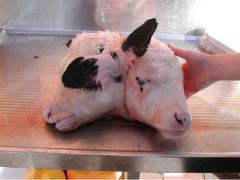
If you palpated this calf within the uterus of a cow experiencing dystocia how would you proceed with attempting a vaginal delivery?
|

Partial Foetotomy - reduce size of bicephalic head to allow delivery (Wrong picture, can't change it)
|
|
|
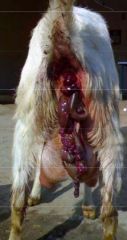
This goat presented with dystocia. What is your differential diagnosis?
|

Uterine rupture, schistosomus reflexus, retained placenta. On closer examination intestines and foetal organs are visible indicating that the organs and viscera are of foetal origin. The most likely diagnosis is schistosomus reflexus. The picture above shows the appearance of the foetal kid following delivery. Schistosomus relflexus is rare in sheep and goats but it occurs occasionally.
|
|

